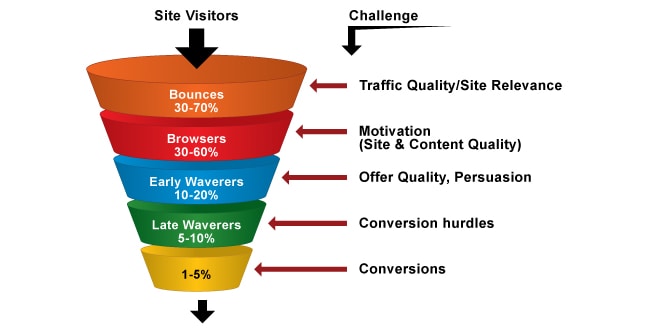
Most people attribute Search Engine Optimization (SEO) as vital to the success of an online business. However, very few people even know about Conversion Rate Optimization (CRO), let alone do they realise how important this is. I am not saying that SEO is not important. SEO enables a website to be found. But it is ultimately Conversion Rate Optimization that converts the users who find your site into customers.
Conversion Rate Optimization can be defined as the method of creating an experience for a website or landing page visitor with the goal of increasing the percentage of visitors that convert into customers (Source). This essentially means that first someone visits your website and is convinced by what you have to offer; then he or she chooses to make a purchase through you. This process means that they will have been converted into an actual customer from a mere website visitor.

Factors Which Influence Conversion Rates
In order to simplify our discussion, let us take an e-commerce website as an example. Some of the most important factors that would influence conversion rates on an e-commerce website would be:
-
- Website Navigation: If your website navigation systems are unclear, slow loading, or labelled with ambiguous titles, your website visitors will simply leave your website with a strong feeling of frustration. The key to website success is to keep it simple! You need to guide people through your website easily while showing them where they are currently located within the site hierarchy. At the same time, it is important that your visitors do not have to guess where to find the products or information they are looking for. Your font size, colour and styles must be readable also. Some websites go over the top with over-designed fonts and menus, ambiguous names for their shop sections and flamboyant colour schemes. Very often, this strategy is chosen by the site designers in order to stand out and as a consequence attract custom because of this. Unfortunately, they are actually more likely to lose custom. While it is true that in certain specific scenarios, this strategy can work in a real-life shop setting where customers can see and touch products and speak face to face with staff, in an online world where your competitors are a click away, you have to gain customers trust. Very often than not, the clearer your site is the better.
- Clear Photography: Photography is the only way a customer can see and judge a product. If a site has pixelated images, or images which show a product from disadvantageous angles, then it is unlikely a customer will opt to make a purchase. Think of the composition of your photographs, the quality, and the visual perspectives from where they are taken. The more images you can provide of the product, the better. It is also advisable to provide thumbnail versions of products with the option to click on them to see the larger versions.
- Homepage Design: You homepage provides the first impression of your business. Thus, it must be smart and well designed. It also needs to engage your visitors and attract them to explore your website further. More importantly you need to lead them into your online shop so they are tempted to make a purchase. Therefore your homepage should display a well-thought selection of your products, and link to these products within your online shop. There should also be a tag line or a few sentences which sums up what your business is, and what it does.

You will never manage to convert all your site visitors into customers. However, through Conversion Rate Optimization, you will increase your conversion rate. Conversion Rate Optimization is often represented as a
funnel-shaped diagram as shown above (Source: SitePosition)
- Checkout System: The checkout is the point where many e-commerce websites lose customers. If a visitor has browsed through your website and added a few items to their basket, they are very likely to go ahead and make a purchase rather than simply window-shopping. Your website must guide your customer trough a simple purchasing process. Use clearly-labelled buttons to help your customer navigate through each stage of the checkout, and place those vital security logos throughout it so your customer knows it is safe to purchase through your website. Outline any important information they will need to know such as delivery costs and timings, returns information so any doubt for them not to purchase is addressed. Very often, a simple FAQ will do the trick but do consider adding live tech support. It all depends on the type of e-commerce site that you have, the products that you are selling and your sales volume. Make use of your website analytics software to notice browsing patterns of your users, how many are abandoning your site and from which pages they are doing this.
- Grammar: Even something as small as a spelling mistake can put a customer off from making a purchase. Make sure you spell check your site, and ask family members, or, better still hire proofreading services. It is very easy to make a grammatical mistake. By pending most of the time maintaining your site, it is very likely that you will be the person who will miss even the most obvious mistakes. Needless to say, if a mistake is spotted, change it immediately.
Want to learn more?
Are you interested in the intersection between UX and UI Design? The online courses on UI Design Patterns for Successful Software and Design Thinking: The Beginner’s Guide can teach you skills you need. If you take a course, you will earn an industry-recognized course certificate to advance your career. On the other hand, if you want to brush up on the basics of UX and Usability, try the online course on User Experience (or another design topic). Good luck on your learning journey!
(Lead image: Depositphotos)
